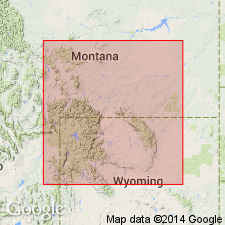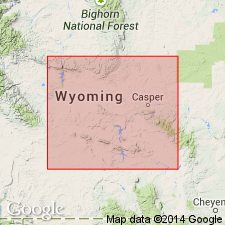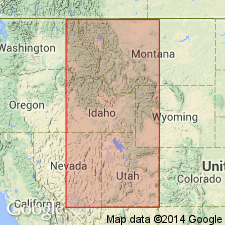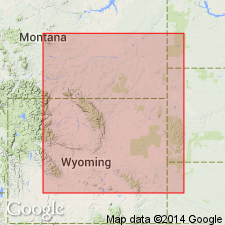
- Usage in publication:
-
- Cottonwood Canyon Member*
- Modifications:
-
- Original reference
- Dominant lithology:
-
- Dolomite
- Siltstone
- AAPG geologic province:
-
- Bighorn basin
Summary:
Name Cottonwood Canyon Member of Madison Limestone (or of Lodgepole Limestone in areas where the Lodgepole is basal formation of Madison Group) is applied to a dark shale unit of Devonian and Mississippian age. Member is divided into a lower and an upper tongue, each of which is further divisible into an eastern dolomitic facies and a western shale and siltstone facies. Both tongues are characterized by basal conglomeratic lag deposits containing abundant phosphatic nodules and coprolites, conodonts, and fish remains, and glauconitic grains. The lag deposits are continuous between the facies of each tongue, and the lag deposit of the upper tongue also continues at the base of the Lodgepole Limestone, even where the upper tongue is too thin to be differentiated. Thickness 0 to 80 feet. In Wyoming the member grades into and intertongues with other strata in lower part of Madison Limestone, whereas in Montana and extreme western Wyoming it generally lies at base of Lodgepole Limestone. Member rests unconformably and locally with marked angularity, on rocks ranging in age from Mississippian to Cambrian and on Precambrian rocks in isolated areas in southeastern Wyoming. Youngest unit that lies directly below the Cottonwood Canyon is Sappington Member of Three Forks Formation in vicinity of Bridger Range in southwestern Montana. East of limit of the Sappington, the Cottonwood Canyon rests unconformably on Trident and Logan Gulch Members of the Three Forks in descending order. Beyond limit of the Three Forks Formation, the Cottonwood Canyon unconformably overlies the thin subsurface Birdbear Formation or the exactly equivalent outcropping Birdbear Member at top of Jefferson Formation.
Type section: on north wall of Cottonwood Canyon, about 1 mi east of the mouth, in sec. 34, T. 57 N., R. 93 W., Big Horn Co., WY. Named from Cottonwood Canyon on west side of northern Bighorn Mountains, 16 mi east of Lovell, in northern WY.
Reference section (shale and siltstone facies): in Beartooth Mountains at Clarks Fork Canyon, north of river in NE/4 NE/4 sec. 7, T. 56 N., R. 103 W., Park Co., WY, in Deep Lake 15-min quadrangle.
Subsurface reference section: depth-interval 5,806.9 to 5,819.2 ft in Pan American 72 Elk Basin Madison Unit well of Elk Basin oil field in northwestern Bighorn basin. Well is in NW/4 SE/4 sec. 30, T. 58 N., R. 99 W., Park Co., WY.
Source: US geologic names lexicon (USGS Bull. 1350, p. 178).

- Usage in publication:
-
- Cottonwood Canyon Member*
- Modifications:
-
- Overview
Summary:
Is equivalent to the Englewood Formation of southeast WY (Wind River, Powder River, and Denver basins).
Source: GNU records (USGS DDS-6; Denver GNULEX).

- Usage in publication:
-
- Cottonwood Canyon Formation
- Modifications:
-
- Revised
- AAPG geologic province:
-
- Wasatch uplift
Summary:
Removed from Lodgepole Formation [Limestone] of Madison Group and raised in stratigraphic rank to formation in northeast UT and adjoining southeast ID on the Wasatch uplift because of its distinctive lithology. Retained as a member of Lodgepole in WY and MT. In Bear River Range and at Causey Reservoir in Cache Co, UT, Cottonwood Canyon is succeeded by the newly named Henderson Canyon Formation which replaces use of Lodgepole in northeast UT and southeast ID. Of early Kinderhookian, Early Mississippian age.
Source: GNU records (USGS DDS-6; Denver GNULEX).

- Usage in publication:
-
- Cottonwood Canyon Member*
- Modifications:
-
- Age modified
- AAPG geologic province:
-
- Powder River basin
- Bighorn basin
- Green River basin
- Wind River basin
Summary:
Assigned to base of author's stratigraphic sequence 4 (Kinderhookian to lower Meramecian). Cottonwood Canyon which occurs within Bighorn, Powder River, Greater Green River, and Wind River basins of study area is laterally equivalent to an unnamed basal clastic unit. Basal clastic unit is time transgressive throughout its areal extent and is at least a partial equivalent to other time transgressive units including Bakken Formation, Paine Member of Lodgepole Limestone, Exshaw Formation, Leatham Formation, Sappington Member of Three Forks Formation, and others. Basal clastic unit and equivalents are disconformable above equivalents of Upper Devonian part of Three Forks Formation in northwest part of study area and above older rocks throughout remainder of area. Basal deposits of sequence 4 were laid down during an early stage of the Ancestral Front Range and Pathfinder uplifts and are overlain conformably (fig. 35) by carbonate rocks deposited during Kinderhookian transgression onto the Wyoming shelf. Maughan (1963, USGS Prof. Paper 475-C) assigned basal clastic unit in Laramie Range to the Mississippian and reported that contact with overlying limestone is gradational and intertonguing. Assigned Kinderhookian age. Late Devonian age reported by Sandberg, Klapper (1967) was based on Late Devonian "indigenous conodonts" collected from a lag deposit at base of Cottonwood Canyon.
Source: GNU records (USGS DDS-6; Denver GNULEX).
For more information, please contact Nancy Stamm, Geologic Names Committee Secretary.
Asterisk (*) indicates published by U.S. Geological Survey authors.
"No current usage" (†) implies that a name has been abandoned or has fallen into disuse. Former usage and, if known, replacement name given in parentheses ( ).
Slash (/) indicates name conflicts with nomenclatural guidelines (CSN, 1933; ACSN, 1961, 1970; NACSN, 1983, 2005, 2021). May be explained within brackets ([ ]).

